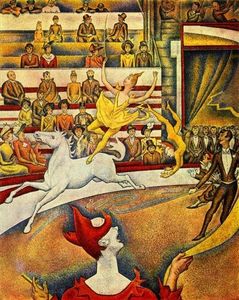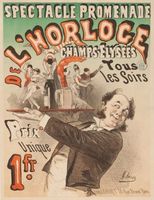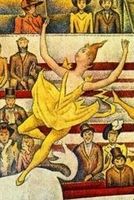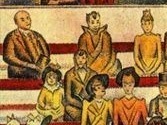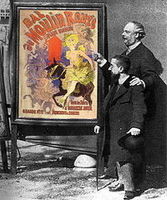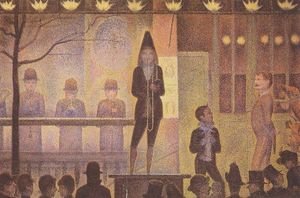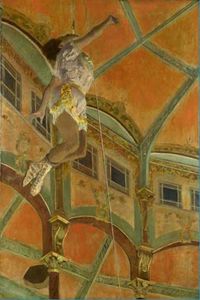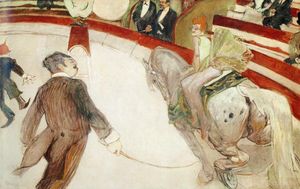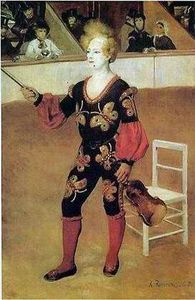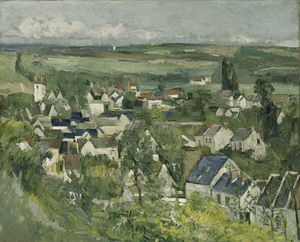The Circus
- Date of Creation:
- 1891
- Height (cm):
- 73.00
- Length (cm):
- 59.00
- Medium:
- Oil
- Support:
- Canvas
- Subject:
- Figure
- Technique:
- Pointillism
- Art Movement:
- Impressionism
- Created by:
- Current Location:
- New York, New York
- Displayed at:
- Museum of Modern Art
The Circus Story / Theme
-

Jules Chéret
-

Spectacle-Promenade de l'Horloge
Mazeppa's ride
Riding bareback on a wild horse had always been a regular performance in circuses of the era; but the performers had previously always been men. Mazeppa's ride gained notoriety because it was the first of its kind to feature a female horse rider. It is likely that Seurat saw this performed in the Paris circus and it inspired that portion of his work.
The Circus is famously known as Georges Seurat's final work before his death in March 1891. Its subject matter is that of the circus, the presence of which increased rapidly towards the end of the 19th century.
Despite being unfinished, the work was still exhibited in the 7th Salon des Independents and courted a great deal of controversy due to its similarity to posters by French painter Jules Chéret and many accused the painter of plagiarism. Seurat's The Circus has been noted as bearing marked similarities to Chéret's posters for the Spectacle-Promenade de l'Horloge. The work has subsequently been proven by art historian Meyer Schapiro, to resemble an anonymous poster printed for the Nouveau Cirque in 1888.
Circuses in France in the 19th century were a spectacle to behold and their menagerie of performers inspired the Impressionists. Such performers often included giants, elephants riding cycles and daring acrobatic acts. The success of circuses in France meant that by 1870 there were five permanent circuses situated in Paris that performed every night.
The difference between circus performers in cities such as London was that in Paris they were awarded much more respect. Such respect had led many of their scenes to be depicted in famous paintings and stories. Seurat's The Circus is one of such works.
One of the most popular circuses of the time and one which Seurat more than likely witnessed was the Cirque Fernando in Montmartre, famous for attracting poets and painters alike. The circus offered a level of intimacy to its performance which could not be replicated anywhere else, curtsey of its steeped seating plan and small arena.
Although unfinished, Seurat's The Circus captures the emotion and movement of one portion of a circus scene. The clown at the front of the piece stands out with white make-up-clad skin against scarlet hair and dress. The smartly dressed ringmaster to the right is placed just in front of a menagerie of clowns and an acrobat who is jumping in front of him. The focal point of the piece is the young woman who is boldly riding the wild white horse to the left-center of the work.
The performer could possibly have been one of the circus world's most prolific acts of the time: Mazeppa's ride. The entire piece contains a great deal of action but perhaps the most eye-catching is this daring act.
Georges Seurat himself did not live to see his work for the duration of its exhibition, but the fact that it was exhibited even in its incomplete form said a great deal about his stature amongst his fellow Impressionists.
The Circus Inspirations for the Work
The Circus:
Circuses at the time were hugely popular in Paris and the flourished by finding ever more extravagant ways to shock and astound their audience. Like many other Impressionist painters Seurat had a great deal of love for the European circus and its rapid expansion meant that he and his fellow artists had no shortage of performances to attend.
Instead of travelling circuses Paris had five permanent ones due to its growing demand. One particular act which may have inspired Seurat to paint The Circus was Adah Menken's Mazeppa's ride. Male performers riding a wild horse bare-back was fairly common, but for the first time Mazeppa's ride incorporated a female model for the daring act. Menken's act has been depicted by the female figure riding the white horse as one of the prominent parts of Seurat's painting.
The Goncourt Brothers:
The Goncourt brothers were a pair of writers who wrote three novels in total, each commenting on different aspects of French social life. The brothers, Edmond de Goncourt and Jules de Goncourt, were inseparable and until Jules' death only spent one day apart from each other. Seurat's specific inspiration no doubt stemmed from their tale about the circus: Freres Zemgano.
The Circus Analysis
Composition:
Next to Seurat's use of color for the piece, his composition is perhaps the most important aspect of the work and is separated into two very distinct portions. Chiefly, the front section is denoted by activity, whilst the back section is for the docile spectators looking on. Both are given almost equal measures of the canvas but for entirely different purposes.
Seurat's theories on brush stroke and its relation to emotion are well developed here. His ideas on chromoluminarism denote that upward stokes equate to gaiety in those that are viewing them. The Circus is full of upwards strokes towards the front of the painting, where the majority of the action is taking place.
Everything in this section of the painting is accentuated to a peak, most notably the hair of both the clown at the front and the performer on the horse. For Seurat's theories, straight lines denote calm and these lines appear only in the rows of seats towards the back of the painting. Here the audience calmly watches the grand spectacle in front of them.
The architecture is the only part of this scene that has straight vertical lines. Even the audience is depicted in a manner which avoids such composition. Audience members sit at an angle and even many of the top hats in the scene are placed at an angle. Seurat's piece is intended to evoke happiness and action throughout and his use of color compliment this perfectly.
Color palette:
Like his composition, Seurat's use of color hinges on his rules of chromoluminarism which denote that bright luminous colors will evoke positive feelings for the viewer. The artist does not shy away from depicting this luminosity to fiery effect and the entire piece is wrapped inside an orange glow.
The three primary colors for this work - red, yellow and orange - resemble that of a flame at different temperatures. Even when black is depicted for the clothing of some of the audience members, its darkened hues are brightened by the orange glow that engulfs everything in the painting.
The rest of the figures in the piece are dressed in similar fiery colors and it gives the entire piece a homely glow. The brightness of the center of the painting almost serves as a fireplace for those gathered around the sides.
Use of light:
Seurat's emotive coloring could not be achieved without his purposeful use of lighting. As this is most likely an evening scene there is no natural lighting but unseen light at the top of the picture bathes everything below it in a familiar orange glow. For figures who are brightly glad this glow is less discernible, but for those wearing darker colors it reflects off of their darker garments.
Mood, tone and emotion:
Seurat was a big fan of the circus in Paris and his work has attempted to capture the excitement and action of the performance. Seurat's theories on chromoluminarism have made his intention with regards mood, tone and emotion explicit to any analysis of the piece.
Brush stroke:
In order to complete his work, Seurat has made use of his unique pointillist technique. The artist's painting comprises of tiny dots of primary colors, which are placed in close proximity to each other to create a third color at a certain viewing distance. Seurat's use of red and yellow in the piece has given it an overtly orange glow.
The Circus Critical Reception
Contemporary reception:
For the most part Seurat's The Circus was well-received and even in its unfinished state was deemed worthy enough to be exhibited in the 7th Salon des Independants. The work was exhibited from March 20 until April 27 but Seurat would not live to see the end of the exhibition.
Posthumous reception:
After Seurat's death there has been a considerable amount of debate as to whether his work was plagiarized from a poster by French-born painter Jules Chéret. One of his posters for the Spectacle-Promenade de l'Horloge bore a remarkable similarity to Seurat's work.
Further research by art historian Meyer Schapiro has subsequently proven that Seurat's work instead is based on an anonymous poster for the Nouveau Cirque.
Modern day reception:
As the final work of a greatly talented painter The Circus courts a great deal of interest from critics seeking to analyze the growth of an artistic movement that would come to reverberate for decades to come. As testament to this, The Circus is currently exhibited at one of Frances most prestigious galleries, the Musée d'Orsay, Paris.
The Circus Related Paintings
The Circus Artist
Seurat began painting The Circus when he was 31 years old and despite being unfinished, it stands as an example of the pointillist technique that Seurat founded and promoted throughout his short life.
Like Seurat's other works, The Circus is vibrantly portrayed with warm yellows, reds and oranges. Seurat was a strong believer in the link between color and emotion and his use of color in this piece is representative of this. Compositionally The Circus makes use of varying lines to evoke different emotions and no part of Seurat's work is without another layer of emotional relevance.
Despite dying at an early age, Seurat displayed such a painting method in vibrant detail throughout his short career. Seurat's artistic style is split into two distinctive sections. His early years in which he heavily favored black and white drawings, whilst in his later years he founded and perfected the artistic method of: Pointillism.
The Circus Art Period
Seurat's paintings came at a critical time for the Impressionist movement, which had established itself as the primary art movement of its era. Despite its new and bold approaches by the time Seurat entered the art scene, artists were beginning to look for a new approach and technique for their work.
Neo-impressionism was born and was a turn to the scientific application of art onto the canvas. Seurat formulated his theories on pointillism and chromoluminarism and they heralded a new era in artistic representation. The Circus is a work that fully exemplifies Seurat's artistic theories and furthered the Neo-Impressionist movement long after his death.
The Circus Bibliography
For further insight into the life and works of Georges Seurat, please refer to the following recommended sources.
• Broude, Norma. Georges Seurat. Rizzoli International Publications, 1992
• Flux, Paul. Georges Seurat (Life and Work Of... ). Heinemann Educational Books, 2002
• Hauptman, Jodi. Georges Seurat: The Drawings. The Museum of Modern Art, 2007
• Russell, John & Seurat, Georges. Seurat. Thames 1989
• Russell, John. Seurat (World of Art). Thames & Hudson Ltd, 1965
• Thomson, R. Seurat and the Bathers. Yale University Press, 1997

